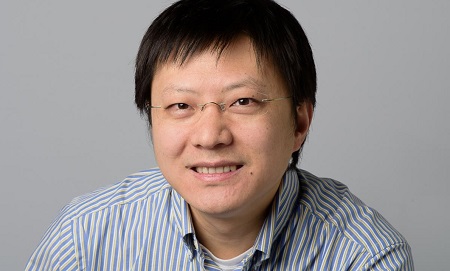Eerste bewijs voor nieuwe supergeleidende toestand in Ising supergeleider
Wetenschappers van de RUG hebben, samen met collega’s uit Nijmegen en Twente en het Chinese Harbin Institute of Technology, experimenteel bewijs ontdekt voor een nieuwe supergeleidende toestand die was voorspeld in 2017. Zij presenteren het bewijs voor een speciale variant van de zogeheten FFLO supergeleidende toestand in een artikel dat op 24 mei verscheen in het wetenschappelijke tijdschrift Nature. De ontdekking kan belangrijke toepassingen hebben, vooral in supergeleidende elektronica.
De hoofdauteur van het artikel is RUG-hoogleraar Device Physics of Complex Materials Justin Ye. Hij werkt met zijn team werken al langer aan de zogeheten Ising supergeleidende toestand. Deze bijzondere toestand is bestand tegen magnetische velden, die doorgaans supergeleiding onmogelijk maken. Deze Ising supergeleiding is door het team beschreven in 2015. En in 2019 maakten zij een schakeling die bestaat uit een dubbele laag molybdeen disulfide, waarin het mogelijk was de Ising supergeleiding in de twee lagen te koppelen. In hun opstelling konden Ye en zijn collega’s de supergeleiding aan of uit schakelen met behulp van een magnetisch veld, waarmee ze een supergeleidende transistor hadden gemaakt.

Evenwicht
De schakeling met gekoppelde Ising supergeleiding werpt licht op een kwestie die lang geleden is aangekaart. In 1964 voorspelden vier wetenschappers (Fulde, Ferrell, Larkin en Ovchinnikov) een speciale supergeleidende toestand die kon bestaan bij een lage temperatuur en een hoog magnetisch veld. Dit werd de FFLO-toestand genoemd. In een gewone supergeleider bewegen de elektronen in tegenovergestelde richting in zogeheten Cooper-paren. Omdat ze precies dezelfde snelheid hebben, is het totale kinetische moment van die paren nul. Maar in de FFLO toestand is er een klein verschil in snelheid tussen de twee elektronen in een Cooper-paar, waardoor dat er een netto kinetische moment aanwezig is.
‘Het bestaan van deze toestand was moeilijk te bewijzen, er is een handvol artikelen verschenen waarin ze is beschreven voor gewone supergeleiding’, vertelt Ye. ‘Maar geen daarvan was echt helemaal overtuigend.’ Om de FFLO staat in een gewone supergeleider te maken is een sterk magnetisch veld nodig. Maar dat magnetisch veld moest wel heel nauwkeurig afgesteld zijn. Kort gezegd, het magnetisch veld kan twee rollen spelen, en van die twee wilde Ye specifiek het Zeeman effect gebruiken. Dit scheidt de elektronen van een Cooper-paar op basis van de richting van hun spin (een magnetische eigenschap), maar niet op basis van het baan-effect – de rol die normaal gesproken supergeleiding onmogelijk maakt. ‘Er is een delicaat evenwicht nodig tussen supergeleiding en het externe magnetische veld’, aldus Ye.
Ising supergeleiding, die Ye met collega’s als eerste heeft beschreven in 2015 in het tijdschrift Science, onderdrukt het Zeeman effect. ‘Door de ingrediënten uit te filteren die gewone FFLO supergeleiding mogelijk maken, ontstond ruimte voor het magnetische veld om zijn andere rol te spelen, via het baan-effect’, aldus Ye.

Kwaliteit
‘Wat we laten zien in ons nieuwe artikel is een duidelijke vingerafdruk van een door het baan-effect geproduceerde FFLO toestand in onze Ising supergeleider’, legt Ye uit. ‘Dit is een ongebruikelijke vorm van de FFLO toestand, die theoretisch is beschreven in 2017.’ De FFLO toestand in gewone supergeleiders kan alleen bestaan bij extreem lage temperatuur en een zeer sterk magnetisch veld, waardoor die lastig te maken is. Maar in de Ising supergeleider van Ye wordt deze toestand bereikt bij een zwakker magnetisch veld en een minder lage temperatuur.
Eigenlijk had Ye al aanwijzingen voor de FFLO toestand gezien in zijn experimenten met de molybdeen disulfide supergeider uit 2019. ‘Maar destijds konden we niet bewijzen dat het echt zo was, omdat ons materiaal niet voldoende kwaliteit had’, zegt Ye. Nu heeft zijn promovendus Puhua Wan wel materiaal van voldoende kwaliteit weten te produceren, waardoor het mogelijk was om aan te tonen dat er inderdaad een kinetisch moment aanwezig was in de Cooper-paren. ‘Het uitvoeren van dit experiment kostte een half jaar, de analyse duurde nog eens een jaar’, vertelt Ye. Wan is de eerste auteur van het Nature-artikel.
En het onderzoek naar deze supergeleidende toestand gaat nog door. Ye: ‘Er is nog veel dat we kunnen leren. Bijvoorbeeld, hoe beïnvloedt het kinetische moment de fysische parameters? Het bestuderen hiervan zal nieuwe inzichten opleveren in supergeleiding. En het kan ons in staat stellen om deze staat te controleren in schakelingen zoals transistoren. Dat is onze volgende uitdaging.’
Referentie: Puhua Wan, Oleksandr Zheliuk, Noah F.Q. Yuan, Xiaoli Peng, Le Zhang, Minpeng Liang, Uli Zeitler, Steffen Wiedmann, Nigel E. Hussey, Thomas T.M. Palstra & Jianting Ye: Orbital Fulde–Ferrell–Larkin–Ovchinnikov state in an Ising superconductor. Nature, 24 mei 2023
Meer nieuws
-
06 januari 2026
AI-phasie: kunstmatige intelligentie helpt bij taalgebrek
